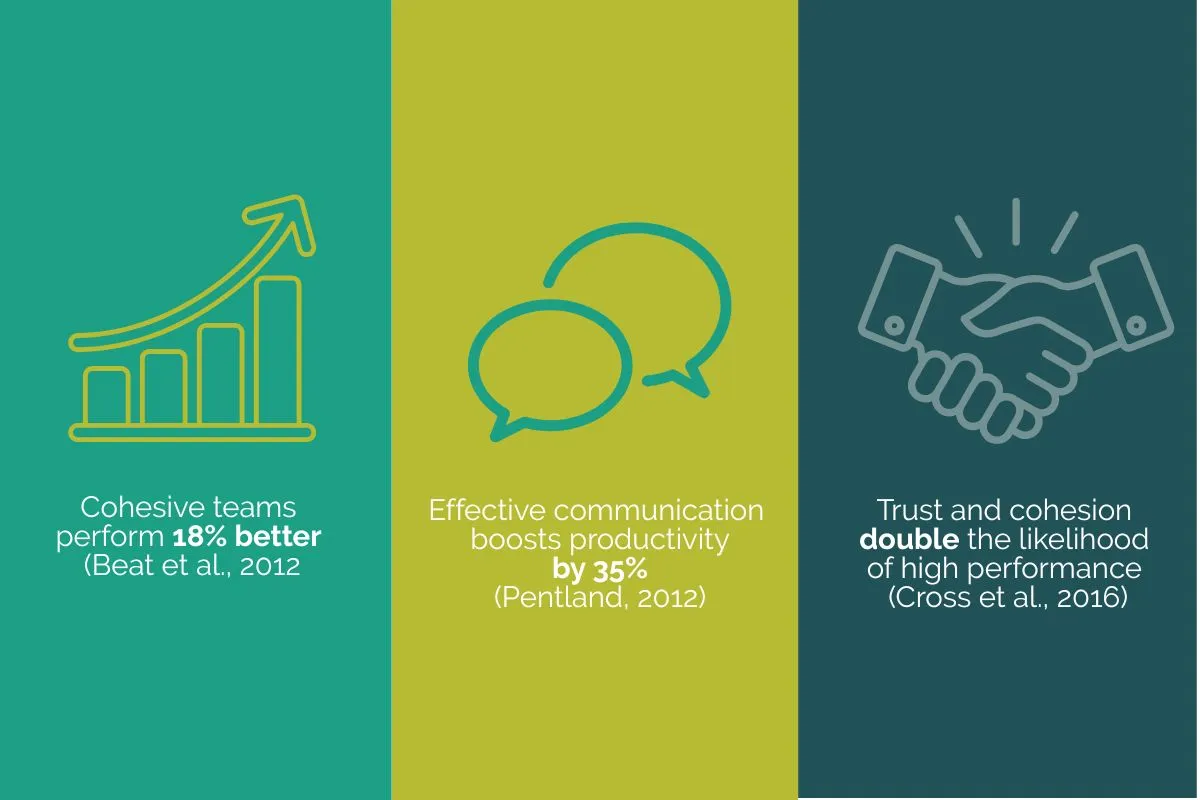Authors: Natalie Foley and Michelle Fourie
In today’s fast-changing workplace, strong teams aren’t just nice to have — they’re essential. High-performing teams drive strategy, innovation, engagement, and results. Yet, team development is often overlooked or underfunded.
So, what is team enablement:
Team enablement is all about giving teams what they need, to do their best work. It means making sure people have the right tools, skills, support, and environment to succeed together. This could include clear goals, helpful feedback, access to training, or systems that make collaboration easier. When teams feel supported and empowered, they’re more motivated, productive, and aligned — which leads to better results for everyone.
Why Team Enablement Matters
Team enablement delivers measurable value. When done right, it creates healthier, more productive teams — and better business outcomes.
Key Benefits:
Here is why it matters:

Tangible ROI:
The Return on Investment (ROI) for organisations investing in team enablement can be significant.
Increased productivity: High-performing teams typically complete projects faster and with fewer errors.
Reduced turnover costs: Team development improves morale and engagement, lowering employee attrition rates.
Fewer conflicts and smoother collaboration: Training in communication and conflict resolution reduces time lost in interpersonal issues.
Improved project outcomes: Teams that trust each other and have clear roles/dynamics tend to deliver better quality work.
Customer satisfaction and retention: Better teamwork often translates to improved service delivery and client interactions.
What the research says:
Teams with high cohesion outperform others. This is supported by research that shows team development pays off — fast.
A meta-analysis by the American Psychological Association (Beal et al., 2003) found that cohesive teams outperform non-cohesive teams by 18% across various industries.
Research published in the Harvard Business Review (Pentland, 2012) revealed that teams with strong cohesion and effective communication are 35% more productive, regardless of individual skills or intelligence.
Additional findings by Cross et al. (2016) highlighted that teams with strong social cohesion and trust are more than twice as likely to excel. Such teams can make decisions more swiftly and with greater consensus, thereby shortening project cycle times.

Introducing the JVRC Team Enablement Model
The JVRC Team Enablement Model offers a research-based, flexible framework for enhancing team effectiveness in diverse organisational contexts. The model focuses on diagnosing current team dynamics, applying relevant assessment tools, and facilitating targeted interventions to strengthen collaboration, communication, and performance.
Core Scenarios:
The model offers a useful framework to classify team needs into three typical scenarios:
Establish (Form): New teams forming their foundation.
Transition (Change): Teams navigating change.
Challenge (Conflict): Teams dealing with conflict or dysfunction.
These scenarios will influence the approaches followed since teams have differing needs depending on the stage they are in, and not all diagnostic tools can be used in every context.
Our Approach:
Our JVRC Team Enablement Behavioural Model (Figure 1) proposes five core team-level behaviours, supported by additional contextual components.
Trust: Foundation of psychological safety.
Synergy: Productive collaboration and shared strengths.
Ownership: Accountability, initiative, and mutual accountability.
Shared Vision: Alignment on common purpose and goals.
Growth Mindset: Resilience, continuous learning, and openness to change.

These behaviours are assessed across both tangible systems and intangible culture, supported by two key factors:
The Individual: Recognises that the team is only as strong as its members. Individual competence and readiness must be evaluated using tools like the JVR33 Competency Framework to ensure foundational behavioural skills are present (JVR Africa Group, 2025).
The Context: Considers the external and internal environment in which the team operates. Organisational culture, leadership style, available resources, and socio-economic factors all impact team functioning and must be factored into intervention design.
How We Work With Teams
Our team enablement workshops bring the model to life.
Through assessment-driven, facilitated sessions, we help teams identify growth areas, align around goals, and develop the tools to work more effectively together. Each session is tailored to the team’s unique needs — whether it’s conflict resolution, role clarity, or better communication.
Practical Tools That Drive Results:
The High Performing Team Assessment (HPTA) diagnoses strengths and gaps, builds openness, and guides long-term improvement.
In a session conducted with an organisation who had grown rapidly in a short period of time, the HPTA was used to assist the team in gaining a deeper understanding of their current state, to create a clear vision for the future with practical strategies for achieving high performance.
The Myers-Briggs Type Indicator (MBTI) promotes self-awareness and empathy, improving team communication and cohesion.
The MBTI has also been used in various settings but most recently a workshop was conducted where the focus was on increasing the team members’ self-awareness, enabling them to understand and appreciate differences to foster stronger relationships and enhance communication.
Simple questionnaires can also be used to understand a team's perspective.
Asking targeted but anonymous questions, like the ones listed below, can help uncover potential challenges that are top of mind for the team.
• Team strengths and successes
What are the team’s strengths?
o What factors have contributed to the team’s success?
o In what ways do you believe each team member’s strengths are being recognised and utilised?
Organisations could then consider following this up with focus groups that look at “Stop, Start, Continue” behaviours for the team. Creating a team charter outlining purpose, goals, operational, and behavioural guidelines will also enable the team to work more productively.
Summary
Strong, cohesive teams are essential for organisations to succeed in today’s fast-paced and complex work environments. Investing in team enablement leads to clear, measurable benefits such as improved productivity, reduced conflict, lower turnover, and better project outcomes. Research consistently shows that team cohesion and effective communication significantly enhance performance, often more than individual talent alone.
Effective team enablement requires a structured approach. This includes assessing current dynamics, understanding the context in which the team operates, and targeting behaviours that support collaboration and accountability. Critical behaviours like trust, shared vision, ownership, synergy, and a growth mindset form the foundation of high-performing teams.
Tools like assessments, facilitated workshops, and reflective exercises can help teams better understand themselves and each other, identify challenges, and set a course for improvement. By doing so, organisations create environments where teams can adapt, align, and thrive together.
References
Beal, D. J., Cohen, R. R., Burke, M. J., & McLendon, C. L. (2003). Cohesion and performance in groups: A meta-analytic clarification of construct relations. Journal of Applied Psychology, 88(6), 989–1004. https://doi.org/10.1037/0021-9010.88.6.989
Cross, J., Rebele, R., & Grant, A. (2016). Collaborative overload. Harvard Business Review, 94(1), 76–85. https://hbr.org/2016/01/collaborative-overload
Valente, Angela. (2025, April 30). Talent identification transformed: Driving organisational success with the JVR Competency Framework. JVR Africa Group. https://jvrafricagroup.co.za/blog/talent-identification-transformed-driving-organisational-success-with-the-jvr-competency-framework
Pentland, A. (2012, April). The new science of building great teams. Harvard Business Review, 90(4), 60–69. https://hbr.org/2012/04/the-new-science-of-building-great-teams
Share this post
Newsletter
Get up-to-date industry news right in your inbox



